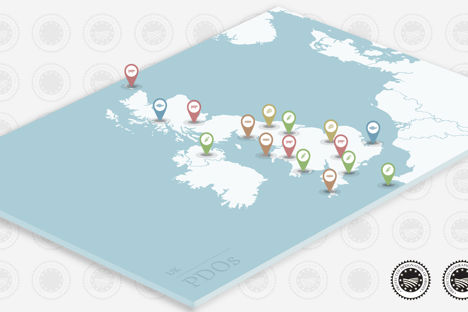
Protected food classifications in the UK
The United Kingdom has a wealth of agricultural produce, of which many are protected under the European protected foods scheme. This system identifies foods with unique characteristics or production methods in order to safeguard their continued production. Here we explain the various EU classifications and the protected UK foods.
Protected food classifications in the UK
The United Kingdom has a wealth of agricultural produce, of which many are protected under the European protected foods scheme. This system identifies foods with unique characteristics or production methods in order to safeguard their continued production. Here we explain the various EU classifications and the protected UK foods.
Unlike other European countries such as France, Italy, Spain and Portugal, Britain did not have its own legally protected foods before European Union legislation came into force in 1993. Whereas other countries have had to harmonise their existing systems with the new EU rules, in Britain the system was adopted in its entirety from the beginning. However, as there has not been a strong history of protecting foods in Britain, there are still relatively few protected foods in the country.
As with all other countries in the EU, there are three types of European protection available for foods or agricultural products. Wines have their own scheme and are classified separately, although they still bear the same PDO/PGI labels.
Number of protected foods: 71
PDO — Protected Designation of Origin
This is the strongest protection that can be afforded to a food. It is used to classify food with characteristics that are completely unique to a place or region.
To qualify for this status, the food must meet two specific criteria:
The essential properties of the food must be determined by the geographical location – both natural influences and distinct local knowledge.
All aspects of the production must take place in this area.
Historically called ‘The Rhubarb Triangle’, this area lies in the cold shadow of the Pennines and connects the boundaries of Leeds, Wakefield and Bradford. This area is mapped precisely using road networks. The geographic location produces specific soil and climatic conditions — it is cold, wet and the soil retains water all year. These conditions enable the natural production of rhubarb without the use of cold stores or chemicals.
There are very specific production techniques which are reliant on generations of local knowledge. These apply to all stages of the growing cycle from propagation of new plants to harvesting mature stalks, and all take place in ‘The Triangle’. Traditional organic feeds like shoddy (a waste product of the local wool industry) are used, which is specific to the area.
The result is rhubarb with intensely coloured skin, a delicate, lightly acidic flavour and tender texture.
PGI — Protected Geographical Indication
This protection is afforded to foods that have a connection with a place or region.
To qualify for this status, the food must meet two specific criteria:
The essential properties of the food must be connected to a geographical location – either natural influences or distinct local knowledge.
At least one aspect of the production must take place in this area.
Pembrokeshire is situated in the most western point of Wales, surrounded by sea on three sides which is warmed by The Gulf Stream. The milder climate this produces facilitates early growth and eliminates the risk of frosts during the growing season, meaning shorter growing times and increased freshness. The entire geology of Pembrokeshire is ancient — more than 280 million years old — and these distinct rocks and soils contribute to the uniqueness of the potato.
The seeds are sourced from basic seed varieties — not necessarily from Pembrokeshire. Further processing, such as washing, can also take place elsewhere.
For PGI foods, where the geographic influence on the foodstuff is not completely unique, the geographic connection can be tradition, reputation or history. In Pembrokeshire, there are hundreds of years of history of potato growing in the area and specific local knowledge of soil and climate is used to determine how to prepare the soil, how to ready seed potatoes for planting, when to plant and how to harvest.
The result is potatoes with a soft skin, a distinctive earthy, nutty flavour, a creamy texture and bright white flesh.
TSI — Traditional Speciality Guaranteed
This protection is afforded to foods that are made under a traditional name, using a traditional method.
To qualify for this status, the food must meet two specific criteria:
The product must have characteristics that distinguish it from similar products and although methods of production are historically fixed in the same way as PDO and PGI, they must have been consistent for at least the past thirty years.
The characteristics cannot be due to the geographical location.
This pork must be made from pedigree Gloucestershire Old Spots pigs — an unimproved breed — and the protection applies to all pork products made from the pig, including bacon, sausages, gammon and hams.
The pigs must be raised using traditional, non-intensive farming methods, in an environment that enables them to grow naturally. There are limits on feed and rearing, and they must be slaughtered in small-scale abattoirs and hung on the bone for three–four days.
The result is pork meat with more fat, less muscle, greater retention of moisture during cooking, elevated tenderness and juiciness and a unique flavour profile.

